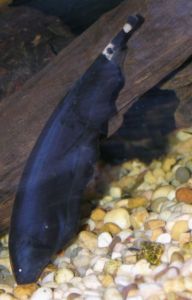Is there another species of fish that has a more badass name than the black ghost knifefish? I doubt it. The combination of ‘black’, ‘ghost’, and ‘knifefish’ just make me think of some kind of underwater ninja. Which, in a way, the black ghost knifefish almost is. At least, they’re sneaky and hang around in the dark all the time. That’s what ninja do, right?
Black ghost knifefish are found in South America, from Venezuela to Paraguay. These are freshwater fish, and prefer waters that are fast moving, with sandy bottoms. Knifefish like areas with lots of vegetation and good places to hide.
Black ghost knifefish are black, with two white markings on their tails. Some fish have a white stripe that runs from the tip of the snout along the back. They are long and slender (hence the ‘knife’ part of their name), and can grow to a maximum of 50cm in length. Knifefish have one long fin on their undersides, and use this fin to move, waving it back and forth to propel themselves around.
To act more like ninja, black ghosts are only active at night. However, it’s pretty difficult to navigate streams that are thick with vegetation in the middle of the night, so black ghost knifefish have developed some senses to help them get around. Three particular systems are useful for this night-loving fish: active electrolocation, passive electrolocation, and lateral line sensing (found in most fish).

Active electrolocation involves the fish emitting an weak electrical signal, which allows the black ghost to locate objects from the disturbances in the signal. Passive electrolocation lets the fish sense electric signals from other sources, such as another knifefish. The fish have two different receptor organs for each of these senses. Finally, the fish’s lateral line detects changing movements and vibrations in the water.
The electric signals generated by knifefish aren’t just used for navigation; after all, why develop such a cool ability if you aren’t going to use it for more than one thing? Knifefish also use electricity to communicate — and these communications can be quite complex. Each species of knifefish (yes, there is more than one) uses a different frequency of signal, and within species signals vary with gender and age. Female black ghost fish have higher frequency signals, while subordinate fish gradually lose signal frequency when in the presence of dominant fish.
So though they may not be actual ninja, there’s no denying that black ghost knifefish are super cool. After all, they talk via electricity. Oh, and the ghost part of their name originates from the belief that the souls of the dead hang out in these fish. Maybe they try and communicate with us via their electrical signals. Spooky stuff.
Cover image by Vassil, CC0, via Wikimedia Commons
